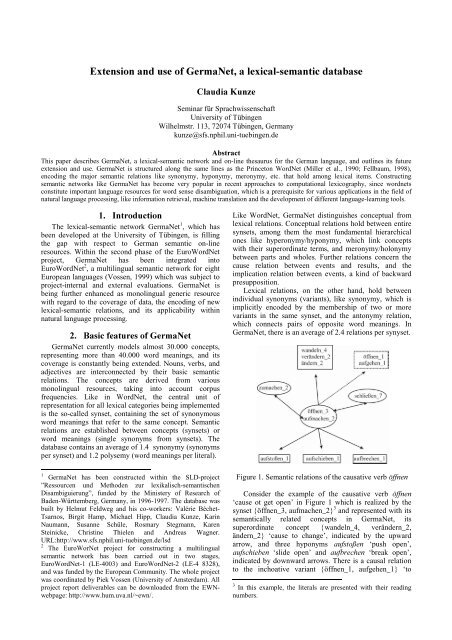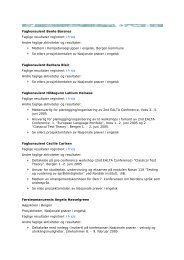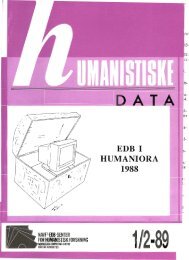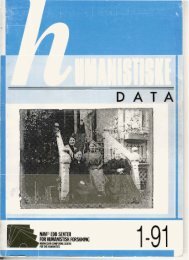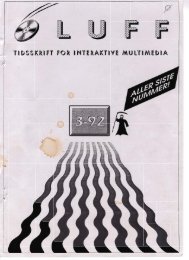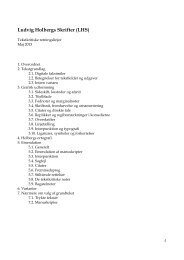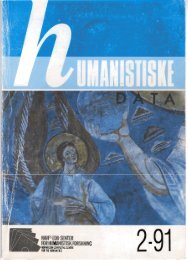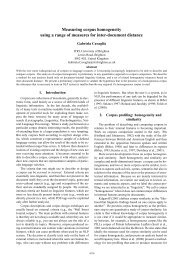Extension and use of GermaNet, a lexical semantic database
Extension and use of GermaNet, a lexical semantic database
Extension and use of GermaNet, a lexical semantic database
You also want an ePaper? Increase the reach of your titles
YUMPU automatically turns print PDFs into web optimized ePapers that Google loves.
([WHQVLRQ DQG XVH RI *HUPD1HW D OH[LFDO VHPDQWLF GDWDEDVH<br />
&ODXGLD .XQ]H<br />
Seminar für Sprachwissenschaft<br />
University <strong>of</strong> Tübingen<br />
Wilhelmstr. 113, 72074 Tübingen, Germany<br />
kunze@sfs.nphil.uni-tuebingen.de<br />
$EVWUDFW<br />
This paper describes <strong>GermaNet</strong>, a <strong>lexical</strong>-<strong>semantic</strong> network <strong>and</strong> on-line thesaurus for the German language, <strong>and</strong> outlines its future<br />
extension <strong>and</strong> <strong>use</strong>. <strong>GermaNet</strong> is structured along the same lines as the Princeton WordNet (Miller et al., 1990; Fellbaum, 1998),<br />
encoding the major <strong>semantic</strong> relations like synonymy, hyponymy, meronymy, etc. that hold among <strong>lexical</strong> items. Constructing<br />
<strong>semantic</strong> networks like <strong>GermaNet</strong> has become very popular in recent approaches to computational lexicography, since wordnets<br />
constitute important language resources for word sense disambiguation, which is a prerequisite for various applications in the field <strong>of</strong><br />
natural language processing, like information retrieval, machine translation <strong>and</strong> the development <strong>of</strong> different language-learning tools.<br />
,QWURGXFWLRQ<br />
The <strong>lexical</strong>-<strong>semantic</strong> network <strong>GermaNet</strong> 1 , which has<br />
been developed at the University <strong>of</strong> Tübingen, is filling<br />
the gap with respect to German <strong>semantic</strong> on-line<br />
resources. Within the second phase <strong>of</strong> the EuroWordNet<br />
project, <strong>GermaNet</strong> has been integrated into<br />
EuroWordNet 2 , a multilingual <strong>semantic</strong> network for eight<br />
European languages (Vossen, 1999) which was subject to<br />
project-internal <strong>and</strong> external evaluations. <strong>GermaNet</strong> is<br />
being further enhanced as monolingual generic resource<br />
with regard to the coverage <strong>of</strong> data, the encoding <strong>of</strong> new<br />
<strong>lexical</strong>-<strong>semantic</strong> relations, <strong>and</strong> its applicability within<br />
natural language processing.<br />
%DVLF IHDWXUHV RI *HUPD1HW<br />
<strong>GermaNet</strong> currently models almost 30.000 concepts,<br />
representing more than 40.000 word meanings, <strong>and</strong> its<br />
coverage is constantly being extended. Nouns, verbs, <strong>and</strong><br />
adjectives are interconnected by their basic <strong>semantic</strong><br />
relations. The concepts are derived from various<br />
monolingual resources, taking into account corpus<br />
frequencies. Like in WordNet, the central unit <strong>of</strong><br />
representation for all <strong>lexical</strong> categories being implemented<br />
is the so-called synset, containing the set <strong>of</strong> synonymous<br />
word meanings that refer to the same concept. Semantic<br />
relations are established between concepts (synsets) or<br />
word meanings (single synonyms from synsets). The<br />
<strong>database</strong> contains an average <strong>of</strong> 1.4 synonymy (synonyms<br />
per synset) <strong>and</strong> 1.2 polysemy (word meanings per literal).<br />
1 <strong>GermaNet</strong> has been constructed within the SLD-project<br />
”Ressourcen und Methoden zur lexikalisch-semantischen<br />
Disambiguierung”, funded by the Ministery <strong>of</strong> Research <strong>of</strong><br />
Baden-Württemberg, Germany, in 1996-1997. The <strong>database</strong> was<br />
built by Helmut Feldweg <strong>and</strong> his co-workers: Valérie Béchet-<br />
Tsarnos, Birgit Hamp, Michael Hipp, Claudia Kunze, Karin<br />
Naumann, Susanne Schüle, Rosmary Stegmann, Karen<br />
Steinicke, Christine Thielen <strong>and</strong> Andreas Wagner.<br />
URL:http://www.sfs.nphil.uni-tuebingen.de/lsd<br />
2 The EuroWorNet project for constructing a multilingual<br />
<strong>semantic</strong> network has been carried out in two stages,<br />
EuroWordNet-1 (LE-4003) <strong>and</strong> EuroWordNet-2 (LE-4 8328),<br />
<strong>and</strong> was funded by the European Community. The whole project<br />
was coordinated by Piek Vossen (University <strong>of</strong> Amsterdam). All<br />
project report deliverables can be downloaded from the EWNwebpage:<br />
http://www.hum.uva.nl/~ewn/.<br />
Like WordNet, <strong>GermaNet</strong> distinguishes conceptual from<br />
<strong>lexical</strong> relations. Conceptual relations hold between entire<br />
synsets, among them the most fundamental hierarchical<br />
ones like hyperonymy/hyponymy, which link concepts<br />
with their superordinate terms, <strong>and</strong> meronymy/holonymy<br />
between parts <strong>and</strong> wholes. Further relations concern the<br />
ca<strong>use</strong> relation between events <strong>and</strong> results, <strong>and</strong> the<br />
implication relation between events, a kind <strong>of</strong> backward<br />
presupposition.<br />
Lexical relations, on the other h<strong>and</strong>, hold between<br />
individual synonyms (variants), like synonymy, which is<br />
implicitly encoded by the membership <strong>of</strong> two or more<br />
variants in the same synset, <strong>and</strong> the antonymy relation,<br />
which connects pairs <strong>of</strong> opposite word meanings. In<br />
<strong>GermaNet</strong>, there is an average <strong>of</strong> 2.4 relations per synyset.<br />
Figure 1. Semantic relations <strong>of</strong> the causative verb |IIQHQ<br />
Consider the example <strong>of</strong> the causative verb |IIQHQ<br />
‘ca<strong>use</strong> ot get open’ in Figure 1 which is realized by the<br />
synset {öffnen_3, aufmachen_2} 3 <strong>and</strong> represented with its<br />
<strong>semantic</strong>ally related concepts in <strong>GermaNet</strong>, its<br />
superordinate concept {w<strong>and</strong>eln_4, verändern_2,<br />
ändern_2} ‘ca<strong>use</strong> to change’, indicated by the upward<br />
arrow, <strong>and</strong> three hyponyms DXIVWR‰HQ ‘push open’,<br />
DXIVFKLHEHQ ‘slide open’ <strong>and</strong> DXIEUHFKHQ ‘break open’,<br />
indicated by downward arrows. There is a causal relation<br />
to the inchoative variant {öffnen_1, aufgehen_1} ‘to<br />
3<br />
In this example, the literals are presented with their reading<br />
numbers.
get/become open’, being illustrated by the dotted arrow<br />
pointing to the concept. Both synset variants <strong>of</strong> causative<br />
|IIQHQ have different antonyms (|IIQHQB ↔ schließen_7,<br />
<strong>and</strong> aufmachen_2 ↔ zumachen_2); thus the variants <strong>and</strong><br />
not the entire concepts are interrelated by the bidirectional<br />
arrows.<br />
Although the design principles <strong>and</strong> the <strong>database</strong><br />
technology have been adopted from Princeton WordNet,<br />
some principle-based modifications are applied in<br />
<strong>GermaNet</strong> with respect to the employment <strong>of</strong> artificial<br />
nodes in the hierarchy <strong>and</strong> cross-classification, to the<br />
syntax-<strong>semantic</strong>s interface <strong>and</strong> to the treatment <strong>of</strong><br />
adjectives.<br />
$UWLILFLDO FRQFHSWV<br />
In contrast to WordNet, <strong>GermaNet</strong> makes <strong>use</strong> <strong>of</strong><br />
artificial concepts 4 which may refer either to <strong>lexical</strong> gaps<br />
in the language or to non-<strong>lexical</strong>ized terms, which are<br />
introduced to balance the hierarchies <strong>and</strong> to avoid<br />
unmotivated co-hyponymy. Consider the example given in<br />
Figure 2 which contains two artificial concepts<br />
("6FKXOOHKUHU ‘teacher <strong>of</strong> a certain type <strong>of</strong> school’ <strong>and</strong><br />
"KLHUDUFKLVFKHU /HKUHU ‘teacher w.r.t. to an hierarchical<br />
position’) that help to structure the partial network within<br />
the <strong>semantic</strong> field /HKUHU ‘teacher’ more adequately.<br />
Following Cr<strong>use</strong> (1986), co-hyponyms should be, on the<br />
basis <strong>of</strong> an underlying similarity, incompatible to each<br />
other. For example, the hyponyms <strong>of</strong> .LQG ‘child’ like<br />
%DE\ ‘baby’, .OHLQNLQG ‘toddler’, 6FKXONLQG ‘pupil’ are<br />
mutually exclusive. Since a teacher <strong>of</strong> a certain subject<br />
()DFKOHKUHU) is also a teacher <strong>of</strong> a certain type <strong>of</strong> school<br />
<strong>and</strong> as well a teacher in a certain hierarchical position, the<br />
<strong>lexical</strong>ized hyponyms <strong>of</strong> /HKUHU ‘teacher’ are not mutually<br />
exclusive. Incompatible hyponyms are therefore collected<br />
under the nodes <strong>of</strong> the corresponding artificial concepts.<br />
Figure 2. Artificial concepts in <strong>GermaNet</strong><br />
Artificial nodes are also introduced for verbs <strong>and</strong><br />
adjectives. For example, <strong>GermaNet</strong> distinguishes for<br />
descendent nodes <strong>of</strong> the verb concept HVVHQ ‘eat’ between<br />
"$UWBHVVHQ ‘manner <strong>of</strong> eating’ <strong>and</strong> "=HLWBHVVHQ ‘time <strong>of</strong><br />
eating’, so that concepts like VFKOLQJHQ ‘gobble’ <strong>and</strong><br />
4 Artificial concepts are identified by an initial question mark so<br />
that they can be retrieved automatically.<br />
IU KVW FNHQ ‘to have breakfast’ do not surface as cohyponyms.<br />
In <strong>GermaNet</strong>, adjectives are modeled following the<br />
same taxonomic approach (as opposed to the satellite<br />
approach to adjectives within WordNet) like for nouns<br />
<strong>and</strong> verbs. Since the hierarchical depth <strong>of</strong> adjectival<br />
taxonomies is quite flat compared to those <strong>of</strong> nouns <strong>and</strong><br />
verbs, artificial concepts are necessary to head the subnetworks,<br />
i.e. in the field <strong>of</strong> adjectives <strong>of</strong> perception<br />
("IDUEVSH]LILVFK ‘w.r.t. colour’ is the superodinate <strong>of</strong> the<br />
colour terms).<br />
&URVV FODVVLILFDWLRQ<br />
In <strong>GermaNet</strong>, concepts, which belong to different<br />
hierarchies, are <strong>of</strong>ten cross-classified. So the concepts can<br />
be accessed according to different meaning aspects, i.e.<br />
the cross-classification <strong>of</strong> animals like :HOOHQVLWWLFK<br />
‘budgerigar’ as 9RJHO ‘bird’ <strong>and</strong> +DXVWLHU ‘pet’.<br />
Figure 3. Cross-classification <strong>of</strong> animals<br />
From a theoretical point <strong>of</strong> view, systematic crossclassification<br />
may help to detect productive patterns <strong>of</strong><br />
regular polysemy, i.e. %LUNH ‘birch’ as tree <strong>and</strong> kind <strong>of</strong><br />
wood or 7HQQLV ‘tennis’ as sport discipline <strong>and</strong> event.<br />
6XEFDWHJRUL]DWLRQ IUDPHV<br />
<strong>GermaNet</strong> contains some 7.000 verbs for which<br />
subcategorization frames 5 are provided, implying full<br />
disambiguation <strong>of</strong> the verb readings <strong>and</strong> accounting for<br />
verb alternations (Kunze, 1999) which are centered<br />
around the causation relation like<br />
1) the causative-inchoative alternation<br />
a) (U NRFKW GLH 6XSSH. ‘He cooks the soup.’<br />
b) 'LH 6XSSH NRFKW. ‘The soup boils.’<br />
2) the induced action alternation<br />
a) 3HWHU UROOW HLQHQ %DOO ‘Peter rolls a ball.’<br />
b) 'HU %DOO UROOW ‘The ball rolls.’<br />
3) The change-<strong>of</strong>-location vs. change-<strong>of</strong>-possession<br />
alternation<br />
a) (U JLEW VHLQ 0RELOLDU ]X 3HWHU<br />
‘He brings his furniture to Peter.’<br />
b) (U JLEW 3HWHU VHLQ 0RELOLDU.<br />
5 The representation templates <strong>of</strong> the syntactic frames are based<br />
on the complementation codes provided by CELEX (Burnage,<br />
1995) with some minor modifications for reflexive <strong>and</strong><br />
nominative arguments.
‘He gives Peter his furniture.’<br />
4) causative-change-<strong>of</strong>-integrity alternation<br />
a) (U ]HUEULFKW GLH 7DVVH. ‘He breaks the cup.’<br />
b) 'LH 7DVVH ]HUEULFKW. ‘The cup breaks.’<br />
Other diathesis types like eg. the resultative alternation,<br />
which is feasible for activity verbs in the Vendlerian<br />
sense, are predictable <strong>and</strong> need not be accounted for ((U<br />
L‰W GHQ 7HOOHU OHHU ‘He eats the plate clean.’).<br />
The syntactic information should be enriched by providing<br />
for the respective selectional restrictions on verb<br />
complementation <strong>and</strong> the <strong>semantic</strong> roles being assigned to<br />
the arguments involved (see section 3.2.2).<br />
)XWXUH 3HUVSHFWLYHV<br />
Within a national project 6 <strong>and</strong> several co-operations,<br />
we are following two main areas <strong>of</strong> future actions: the<br />
extension <strong>of</strong> our German wordnet, considering the<br />
guidelines <strong>and</strong> st<strong>and</strong>ards <strong>of</strong> the EuroWordNet project <strong>and</strong><br />
the Global WordNet Association, <strong>and</strong> the <strong>use</strong> <strong>of</strong><br />
<strong>GermaNet</strong> within NLP tasks.<br />
([WHQGLQJ *HUPD1HW<br />
Extending <strong>GermaNet</strong> will imply the enhancement <strong>of</strong><br />
the <strong>database</strong> with respect to the quantitative <strong>and</strong><br />
qualitative coverage <strong>of</strong> concepts.<br />
4XDQWLWDWLYH HQKDQFHPHQWV<br />
The number <strong>of</strong> synsets in the <strong>database</strong> shall be<br />
extended to 40.000 concepts, covering 60.000 word<br />
meanings. The corpus-based completion <strong>of</strong> implementing<br />
the German base vocabulary is currently being<br />
complemented by statistical measures <strong>of</strong> the overlap with<br />
other generic German resources like the PAROLE<br />
lexicon.<br />
Frequent <strong>and</strong> common nominalizations <strong>of</strong> verbs <strong>and</strong><br />
adjectives, the lack <strong>of</strong> which has already become obvious<br />
within the EuroWordNet framework, are being accounted<br />
for systematically.<br />
We plan the treatment <strong>of</strong> further <strong>lexical</strong> categories like<br />
adverbs <strong>and</strong> functional categories, which have so far not<br />
been implemented in the <strong>database</strong>.<br />
Furthermore, a terminological sample 7 will be encoded<br />
for the field <strong>of</strong> economy, which serves to investigate the<br />
relationship between general language resource <strong>and</strong><br />
terminological extensions, <strong>and</strong> enables work on the<br />
development <strong>of</strong> ontologies with regard to domain <strong>and</strong><br />
world knowledge (Mädche & Staab, 2000).<br />
4XDOLWDWLYH HQKDQFHPHQWV<br />
Along with these tasks, besides the improvement <strong>of</strong><br />
coverage, we are planning to establish new types <strong>of</strong><br />
<strong>semantic</strong> relations in <strong>GermaNet</strong>. This concerns<br />
particularly the adoption <strong>of</strong> role pointers, which capture<br />
<strong>semantic</strong> roles like AGENT, PATIENT, INSTRUMENT,<br />
that are assigned by verbal predicates <strong>and</strong> adjectives.<br />
Role information supports verb sense disambiguation in<br />
6 A national funding for the extension <strong>of</strong> <strong>GermaNet</strong> is being<br />
provided by the Ministery <strong>of</strong> Research <strong>of</strong> Baden-Württemberg,<br />
Germany, until September 2001 (“Ausbau des <strong>GermaNet</strong> als<br />
nationale Ressource”).<br />
7 We already have included some 500 terms from the field <strong>of</strong><br />
computing as part <strong>of</strong> a EWN-2 subtask.<br />
cases where the syntactic frame is not sufficiently<br />
distinctive, i.e. for occurrences <strong>of</strong> verb alternations <strong>of</strong><br />
which the patient role can surface either in the subject<br />
position or direct object position <strong>of</strong> the predicate, i.e. %DOO<br />
‘ball’ in the following examples:<br />
(i) Er rollte den Ball. ‘He rolled the ball.’<br />
(ii) Der Ball rollte. ‘The ball rolled.’<br />
We are intending to implement more fine-grained<br />
relational pointers for subtypes <strong>of</strong> meronymy 8 <strong>and</strong><br />
antonymy 9 . At least three types <strong>of</strong> meronymy should<br />
obtain different pointers: the physical part-wholerelationship<br />
(between ZKHHO <strong>and</strong> YHKLFOH), the membergroup-relationship<br />
(between OHDGHU <strong>and</strong> JDQJ) <strong>and</strong> the<br />
substance-composition-relationship (between R[\JHQ <strong>and</strong><br />
DWPRVSKHUH).<br />
After some further research, a <strong>semantic</strong> pointer for types<br />
<strong>of</strong> regular polysemy shall be realized.<br />
8VLQJ *HUPD1HW<br />
Semantic wordnets constitute important resources for<br />
word sense disambiguation which may feed various<br />
applications like information retrieval, text categorization<br />
<strong>and</strong> automatic summarization, since the concept nodes <strong>and</strong><br />
relational links among nodes can be <strong>use</strong>d for making<br />
<strong>semantic</strong> inferences, for finding alternative expressions,<br />
<strong>and</strong> for exp<strong>and</strong>ing words to sets <strong>of</strong> <strong>semantic</strong>ally close<br />
concepts.<br />
<strong>GermaNet</strong> will be studied within the framework <strong>of</strong> two<br />
different applications, exploiting the <strong>GermaNet</strong> synsets<br />
<strong>and</strong> relations for the acquisition <strong>of</strong> selectional preferences<br />
<strong>of</strong> verbal <strong>and</strong> adjectival predicates (Wagner & Kunze,<br />
1999) <strong>and</strong> for the <strong>semantic</strong> annotation <strong>of</strong> large corpora<br />
(Buitelaar, 1999).<br />
$FTXLULQJ VHOHFWLRQDO SUHIHUHQFHV<br />
A verbal or adjectival predicate imposes <strong>semantic</strong><br />
constraints, the so-called selectional restrictions, on the<br />
realizations <strong>of</strong> its arguments, i.e. NRFKHQ ‘cook’ requires a<br />
human agent <strong>and</strong> a patient which denotes some food.<br />
The acquisition <strong>of</strong> selectional preferences <strong>of</strong> a<br />
predicate for its syntactic complements 10 in a wordnet can<br />
aid syntactic <strong>and</strong> <strong>lexical</strong> disambiguation both for language<br />
processing <strong>and</strong> human <strong>use</strong>. Syntactic (i) <strong>and</strong> <strong>lexical</strong> (ii)<br />
ambiguity can be resolved by referring to selectional<br />
restrictions like in<br />
(i) Die Suppe kocht die Frau. ‘Soup cooks the<br />
woman.’ (literal)<br />
(ii) Die Frau kocht einen Auflauf. 11 ‘The woman<br />
prepares a baked pudding.’<br />
Only a few predicates have rigid selectional restrictions<br />
like NDOEHQ ‘give birth to a calve’ which selects .XK ‘cow’<br />
8<br />
The EuroWordNet specification allows for five specialised<br />
meronymy pointers with regard to being part <strong>of</strong> a location, being<br />
substance <strong>of</strong> a composition, being member <strong>of</strong> a group, part <strong>of</strong> a<br />
countable thing or part <strong>of</strong> a mass.<br />
9<br />
see Cr<strong>use</strong> (1986) for a detailed overview on different types <strong>of</strong><br />
contrast<br />
10<br />
This investigation will be elaborated in detail in A. Wagner’s<br />
Ph.D. thesis.<br />
11<br />
$XIODXI has also the meaning ‘crowd’
as the sole argument, <strong>and</strong> can be recognized <strong>and</strong> marked<br />
by the lexicographer. The well-known <strong>semantic</strong> features<br />
like DEVWUDNW ‘abstract’ <strong>and</strong> NRQNUHW ‘concrete’ are too<br />
general for covering the base vocabulary; more specific<br />
<strong>semantic</strong> properties for defining the constraints would be<br />
subject to controversial judgements. Statistical methods on<br />
analyzing the co-occurrences <strong>of</strong> predicates <strong>and</strong><br />
complements in large text corpora (Resnik, 1993; Abe &<br />
Li, 1996) help to determine the adequate level <strong>of</strong><br />
generalization, i.e. 1DKUXQJVPLWWHO 12 ‘food’ as preferred<br />
c<strong>and</strong>idate <strong>of</strong> the verb NRFKHQ ‘cook’. Since<br />
1DKUXQJVPLWWHO can be preferred for both the subject <strong>and</strong><br />
object complement <strong>of</strong> NRFKHQ (depending on the<br />
alternation variant), the selectional preferences should be<br />
mapped to the underlying <strong>semantic</strong> role (see McCarthy &<br />
Korhonen, 1998), i.e. the PATIENT role.<br />
The statistical determination <strong>of</strong> selectional preferences <strong>of</strong><br />
predicates ideally yields the <strong>semantic</strong> role preferences for<br />
being encoded or verified in <strong>GermaNet</strong>.<br />
6HPDQWLF WDJJLQJ<br />
<strong>GermaNet</strong> is being applied in a test phase on the semiautomatic<br />
tagging <strong>of</strong> syntactically disambiguated<br />
sentences, which will provide a first step towards the<br />
development <strong>of</strong> reliable tag-sets for the <strong>semantic</strong><br />
annotation <strong>of</strong> corpora 13 . Each literal <strong>of</strong> the syntactically<br />
annotated output is assigned the best match from among<br />
the <strong>GermaNet</strong> synsets. Anyway, several concepts are<br />
missing in the resource, <strong>and</strong> some meanings do not match<br />
exactly, since either <strong>GermaNet</strong> senses are too general or<br />
too fine-grained for capturing the exact meaning which<br />
the (human) sense-tagger has in mind.<br />
For example, the literal *HVFKLFKWH has 7 readings in<br />
<strong>GermaNet</strong> that can be <strong>semantic</strong>ally clustered <strong>and</strong> reduced<br />
to 3 senses (KLVWRU\: the accumulation <strong>of</strong> happenings in the<br />
past; KLVWRU\ as school subject; VWRU\).<br />
Different aspects <strong>of</strong> the same concept ERRN like its<br />
physical representation as countable object <strong>and</strong> its content<br />
will not be treated as instances <strong>of</strong> regular polysemy, but <strong>of</strong><br />
underspecification.<br />
The degree <strong>of</strong> polysemy within <strong>GermaNet</strong> is quite low,<br />
but WordNet meanings require sense clustering<br />
techniques for reducing the <strong>semantic</strong> search space in<br />
information retrieval (Peters et al., 1998).<br />
Consider the term 0LWWHOVWDQGVDQHNGRWHQ ‘anecdotes<br />
typical for members <strong>of</strong> middle classes’ which was object<br />
to tagging <strong>and</strong> could not be detected in <strong>GermaNet</strong>. This<br />
ad-hoc composition, produced in the domain <strong>of</strong> the<br />
subculture music scene, is not <strong>lexical</strong>ized, though<br />
underst<strong>and</strong>able in the given context. Accessing only the<br />
base noun Anekdote ‘anecdote’ may capture the more<br />
relevant meaning component, but the contribution <strong>of</strong> the<br />
first noun <strong>and</strong> the modus <strong>of</strong> combination will be lost.<br />
Thus, some morphological analysis would be very <strong>use</strong>ful.<br />
Feedback on missing literals or meanings in <strong>GermaNet</strong><br />
is provided. Once the first tag-set is defined, the corpus<br />
training phase can be started.<br />
&RQFOXVLRQ<br />
12 1DKUXQJVPLWWHO corresponds to the same level <strong>of</strong> abstraction<br />
like a EuroWordNet base concept.<br />
13 This application is being carried out by P. Buitelaar <strong>and</strong> his<br />
co-workers at the DFKI, Saarbrücken.<br />
This paper has presented the architecture <strong>of</strong> <strong>GermaNet</strong>,<br />
emphasizing its approach to artificial concepts <strong>and</strong> verb<br />
representation, <strong>and</strong> outlines our basic perspectives<br />
concerning the extension <strong>and</strong> <strong>use</strong> <strong>of</strong> the <strong>database</strong> for<br />
important tasks within NLP like sense-tagging <strong>and</strong> the<br />
acquisition <strong>of</strong> selectional preferences. Extending <strong>and</strong><br />
improving <strong>GermaNet</strong> may support the respective<br />
applications, which, on the other h<strong>and</strong>, hint at deficiencies<br />
<strong>and</strong> inconsistencies <strong>of</strong> our resource. We assume that both<br />
lines <strong>of</strong> actions, <strong>database</strong> extension as well as test<br />
applications, will mutually benefit from one another.<br />
5HIHUHQFHV<br />
Abe, N. & H. Li (1996). Learning Word Association<br />
Norms Using Tree Cut Pair Model. In 3URFHHGLQJV RI<br />
��<br />
,QWHUQDWLRQDO &RQIHUHQFH RQ 0DFKLQH /HDUQLQJ.<br />
Buitelaar, P. (1999). Concepts in Multilingual Information<br />
Retrieval. In 3URFHHGLQJV RI (852/$1 , 252-262).<br />
4 th European Summer School on Human Language<br />
Technology. Iasi, Romania. July, 1999.<br />
Burnage, G. (1995). 7KH &(/(; /H[LFDO 'DWDEDVH<br />
5HOHDVH . Max Planck Institute for Psycholinguistics:<br />
Nijmegen, The Netherl<strong>and</strong>s.<br />
Cr<strong>use</strong>, D.A. (1986). /H[LFDO VHPDQWLFV. Cambridge:<br />
Cambridge University Press.<br />
Fellbaum, C. (1998). :RUG1HW $Q (OHFWURQLF /H[LFDO<br />
'DWDEDVH. Cambridge, Mass.: MIT Press.<br />
Kunze, C. (1999). Semantics <strong>of</strong> Verbs within <strong>GermaNet</strong><br />
<strong>and</strong> EuroWordNet. In: Kordoni, E. (ed.), /H[LFDO<br />
6HPDQWLFV DQG /LQNLQJ LQ &RQVWUDLQW %DVHG 7KHRULHV.<br />
Workshop Proceedings <strong>of</strong> the 11 th European Summer<br />
School in Logic, Language <strong>and</strong> Information, 189-200.<br />
Mädche, A. & S. Staab (2000). Semi-Automatic<br />
Engineering <strong>of</strong> Ontologies from Texts. In 3URFHHGLQJV<br />
RI WKH<br />
��<br />
,QWHUQDWLRQDO &RQIHUHQFH RQ 6RIWZDUH<br />
(QJLQHHULQJ DQG .QRZOHGJH (QJLQHHULQJ 6(.( .<br />
McCarthy, D. & A. Korhonen (1998). Detecting Verbal<br />
Participation in Diathesis Alternations. In 3URFHHGLQJV<br />
RI WKH<br />
��<br />
$QQXDO 0HHWLQJ RI WKH $&/. Vol. 2, 1493-<br />
1495. Montreal, Canada.<br />
Miller, G. & R. Beckwith & C. Fellbaum & D. Gross &<br />
K. Miller (1993). )LYH 3DSHUV RQ :RUG1HW. CSL<br />
Report, Vol. 43. Cognitive Science Laboratory,<br />
Princeton University.<br />
PAROLE, German Resources (1998). Produced in LE 2-<br />
4017. Mannheim: Institut für deutsche Sprache.<br />
Peters, W. & I. Peters & P. Vossen (1998). The Reduction<br />
<strong>of</strong> Semantic Ambiguity in Linguistic Resources. In<br />
3URFHHGLQJV RI WKH<br />
��<br />
,QWHUQDWLRQDO &RQIHUHQFH RQ<br />
/DQJXDJH 5HVRXUFHV DQG (YDOXDWLRQ. Granada, Spain.<br />
Resnik, P.S. (1993). 6HOHFWLRQ DQG ,QIRUPDWLRQ $ &ODVV<br />
%DVHG $SSURDFK WR /H[LFDO 5HODWLRQVKLSV. PhD thesis,<br />
University <strong>of</strong> Pennsylvania.<br />
Vossen, P. (1999). EuroWordNet. Building a Multilingual<br />
Database with Lexical-Semantic Networks for the<br />
European Languages. In 3URFHHGLQJV RI (852/$1 ,<br />
262-272). 4 th European Summer School on Human<br />
Language Technology. Iasi, Romania. July, 1999.<br />
Wagner, A. & C. Kunze (1999). Anwendungsperspektiven<br />
des <strong>GermaNet</strong>, eines lexikalisch-semantischen Netzes<br />
für das Deutsche. To appear in: Schröder, B. et al.<br />
(eds.), 3UREOHPH XQG 3HUVSHNWLYHQ FRPSXWHUJHVW W]WHU<br />
/H[LNRJUDSKLH Tübingen:Niemeyer.


